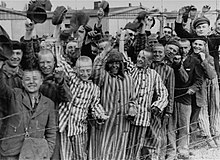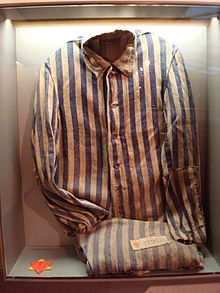Concentration camp inmate clothing
The striped concentration camp prisoner clothing ( camp jargon: zebra clothing ) was introduced as standard clothing for prisoners in National Socialist concentration camps from 1938 to 1939 through the inspection of the concentration camps under Theodor Eicke , presumably beginning with the Dachau concentration camp . The inmates' clothing was previously inconsistent.
The striped prisoner clothing was intended to mark inmates of concentration camps as convicts and to make escape more difficult, for this reason it was partly printed with stripes on the inside.
A distinction must be made between the blue and white striped summer clothing made of half linen and the blue and gray striped winter clothing made of viscose wool . There were special versions for female prisoners. Often incomplete, unsuitable or tattered prison clothing that did not protect against cold or moisture was also given out.
Manufacturing
Since the supposedly “uniform” inmate clothing was made in different workshops or tailoring, there were different cuts, raw material compositions, types of binding, widths of stripes and also color variations. For example, from the spring of 1939, prisoners in the Sachsenhausen concentration camp wore gray-green striped prisoner clothing. From 1936 onwards, at least the necessary materials for prisoner clothing were procured from private companies; from 1939 onwards, striped prisoner clothing was mainly produced - to keep production costs low - by an SS company : the " Deutsche Gesellschaft für Textil- und Lederverarbeitung mbh (Texled ) ”(From 1944“ Deutsche Textil- und Bekleidungswerke GmbH ”). In 1940 this company officially took over the prisoner tailoring of the Ravensbrück concentration camp , in which over 600 female prisoners made the striped prisoner clothing. In the 1940/1941 financial year, 73,000 shirts, 28,500 trousers, 25,000 jackets and 20,000 prisoner coats were produced there. Initially, striped clothing was produced exclusively for male prisoners and only from 1942 on for female prisoners. After the inspection of the concentration camps was subordinated to the SS Economic and Administrative Main Office as Office D in March 1942 , Office D IV acted as the central office for the procurement and determination of requirements for prisoners' clothing.
With the course of the Second World War , the proportion of clothing orders for the Waffen SS increased considerably to the detriment of the prisoners' clothing. Rising numbers of prisoners, a shortage of raw materials, a lack of production capacities and the shift in production to war-necessary textiles made the supply of prisoners with adequate clothing increasingly poor, so that as early as 1942, inadequate prisoner clothing was often given out, as well as marked civilian clothing from victims from the Auschwitz and Majdanek concentration camps . However, marked civilian clothing was only allowed inside the camp; in external detachments it was mandatory to wear striped prisoner clothing because of the risk of escape.
The clothing equipment of the prisoners can thus be divided into three phases during the National Socialist era :
| phase | Period | Inmate clothing |
|---|---|---|
| Phase 1 | 1933-1938 | Civilian clothes with armbands, discarded public service uniforms, single-colored drilies |
| Phase 2 | 1938-1942 | mostly striped prisoner clothing |
| Phase 3 | 1942-1945 | Striped prisoner clothing, in addition also with oil paint (X also KL) or with sewn-on set pieces made of striped prisoner clothing marked civil clothing of killed concentration camp victims of the concentration camps Majdanek and Auschwitz, marked uniforms of murdered Russian soldiers |
Issue and function in the warehouse

Upon arrival at the camp , inmates were required to surrender their clothing and personal effects, undress, take a shower, and have a full body shave before being dressed.
The equipment for male inmates should originally consist of a standard set of summer and winter clothing: 1 cloth jacket, 1 cloth trousers, 1 cloth coat, 1 drill suit, 1 cap, 2 underpants, 2 pairs of socks, 1 pair of foot rags or socks , 1 wool vest, 1 earmuffs, 1 work apron and 1 pair of lace-up shoes or wooden clogs. Women should be given striped dresses and jackets as well as monochrome headscarves as standard.
However, the prisoners in the clothing store were often given absolutely inadequate, unsuitable and tattered prison clothing. In various camps, women imprisoned were not given any footwear from the outset and generally had to stay barefoot , as was common practice in Gestapo women's prison camps .
In the assigned accommodation, the inmate's clothing had to be marked with the appropriate instructions. This labeling system, which has been generally valid since 1937, provided information about the reason for admission in the camp by means of colored fabric triangles or "angles" (example: red = political). In addition, the prisoner number had to be sewn onto the clothing. Functional prisoners , such as kapos , also wore armbands.
Despite the high workload of the prisoners and the associated rapid wear and tear and soiling of the textiles, the clothing was only washed or reissued at long intervals - if at all.
In the camp hierarchy, privileged prisoners, especially kapos, could be recognized by their clean, suitable, often even ironed, zebra clothing and well-polished, sturdy shoes. They were allowed to wash and care for their clothes themselves and, due to their special position, had the opportunity to procure missing items. The appearance of their clothes demonstratively showed their elevated status within the camp and thus brought them considerable advantages over the camp staff and fellow prisoners.
Towards the end of the war, the striped prisoner clothing often protected the evacuation columns from low-flying attacks, as the pilots could identify them as concentration camp columns.
effect
The striped uniform clothing, which was partly understood as costumes in the self-perception, corresponded to the National Socialist prejudice of subhumans in the perception of others and resulted in corresponding treatment by the camp staff. The effect on the German public was inconsistent, from staring and fear to looking the other way and feelings of disgust, but the reactions ranged as well. The stereotype of the criminal or pest was served in this way and was intended to create a deterrent effect in the population.
After the end of the war
After the liberation of the concentration camps, the zebra clothing often made it possible to travel unhindered back home.
Many SS members used the prisoner clothing as a camouflage to escape punishment from the Allies or other prisoners. After the liberation of the Bergen-Belsen concentration camp , for example, Franz Hößler was arrested by a unit of the British army on April 15, 1945 with the other SS men who remained in the camp, although shortly before he had tried to hide in the camp disguised as a prisoner.
Symbol to this day
To this day, the striped prisoner uniform symbolizes persecution and suffering and is sometimes worn with medals by former concentration camp prisoners at commemorative events. In this context, the former prisoner wears the blue and white prisoner clothing as an “honor dress” contrary to its original purpose. In the external presentation, the memory of the survivors and dead of the concentration camps is taken into account, the message Never Again is conveyed and the membership in the prisoner community is demonstrated. The blue and white striped scarf is still the symbol of the former prisoners today.
literature
- Bärbel Schmidt: History and symbolism of the striped concentration camp inmate clothing. Dissertation. Oldenburg 2000 ( publication on the Internet )
- Abstract. ( Memento of April 13, 2005 in the Internet Archive ) (PDF; 12 kB)
- Hermann Kaienburg : The Neuengamme Concentration Camp 1938–1945. Dietz, Bonn 1997, ISBN 3-8012-3076-7 .
- Eugen Kogon : The SS state . Munich 1974, ISBN 3-463-00585-9 .
- Ulrike Dittrich, Sigrid Jacobeit (Hrsg.): Concentration camp souvenirs - commemorative objects of everyday culture in memory of the national socialist crimes. Brandenburg State Center for Civic Education 2005, ISBN 3-932502-45-0 , political-bildung-brandenburg.de (PDF)
Individual evidence
- ^ Rochelle G. Saidel: March 26, 2013
- ↑ Jan Erik Schulte: [1] . March 25.2013
- ↑ Fehrbellin labor education camp: Forced laborers in the Gestapo prison camp, p. 26ff.
- ↑ Karin Orth: The Concentration Camp SS. Munich 2004, ISBN 3-423-34085-1 , p. 266 f.
- ↑ Alexander Prenninger: Symbols and rituals of the liberation celebrations in the Mauthausen concentration camp memorial. In: Ulrike Dittrich, Sigrid Jacobeit (Hrsg.): Concentration camp souvenirs - commemorative objects of everyday culture in memory of the National Socialist crimes. Brandenburg State Center for Political Education, Potsdam 2005, p. 40 ff.



